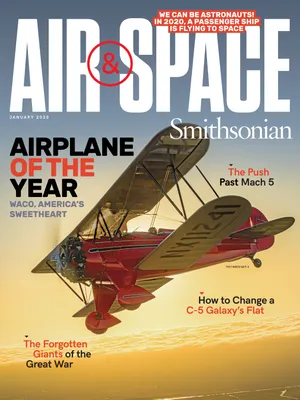With a Loud KABOOM, an F-105 Upstaged Our Air Force Graduation
No one from the Cadet Class of 1968 will forget the day.
:focal(1580x1809:1581x1810)/https://tf-cmsv2-smithsonianmag-media.s3.amazonaws.com/filer/8a/19/8a197759-f89d-47a2-9aec-e2cba69b8afa/17c_dj2020_05f_as08_f105d_live.jpg)
In May 1968, the Vietnam War was at its peak. Our nation’s newest service school, the Air Force Academy, where I was completing my third year of study, was only 14 years old at the time but already had many graduates in combat. To honor the Academy, the United States Air Force sent a decommissioned Republic F-105 Thunderchief—a “Thud,” in USAF language—to be placed on permanent display. A dedication ceremony was scheduled for May 31—the first day of graduation-week festivities for the class of 1968.
The academy’s superintendent, (then) Lieutenant General Thomas S. Moorman Jr. would speak, as would Major General George Simler, a former F-105 wing commander, and Donald Strait, an executive with Republic Aviation, which built the F-105. After their remarks, four Thuds from McConnell Air Force Base in Kansas would perform a fly-by. We occasionally saw individual aircraft fly over, but a formation flight would be a rare thing to witness.
When the appointed day arrived, the assembly crackled with anticipation. We were too busy craning our necks to see the Thuds to pay much attention to the speakers. The Master of Ceremonies got our attention, though, when he told us the flight was being led by Lieutenant Colonel James “Black Matt” Matthews, a veteran of dozens of F-105 combat missions.
We soon spotted the flight of four F-105s in a holding pattern off to the east. Then we saw them turn toward us and take up a diamond formation. We heard their J75 turbojets scream as they flew northward over Mitchell Hall, the air gardens, and Vandenberg Hall.
The F-105 is a beast of an aircraft, a fighter-bomber built for low altitude, high-speed operations. The four Thuds streaked by at what must have been 500 miles per hour. I’ve never forgotten the whistling sound that announced their passing. Though we were in formation, many cadets yelled and whistled at the passing jets, a breach of discipline our superiors were kind enough to overlook.
We expected the formation to recede into the eastern horizon, back to Kansas. But instead they turned south and took up trail spacing. They were lining up to make individual passes!
I could clearly see the lead aircraft turn north. This time though, I could not hear its engine. I noticed a weird quality of light in the air around the Thud. I didn’t know what that meant, but a cadet in the next rank, an aeronautical engineering major, obviously did. I heard him mutter “Oh, shit,” as he clapped his hands over his ears.
The lead aircraft silently streaked by. Then the air around us seemed to shimmer, and we heard and felt the KABOOOOOM as the shock wave swept over us. The F-105 had broken the sound barrier just before passing over our heads.
As the shock wore off, a few cadets began to clap and cheer, but that festive sound was quickly silenced by the Ka-pow! Ka-pow! Ka-pow! of windows shattering in Vandenberg Hall.
General Moorman was purple with rage. The commandant, Brigadier General Robin Olds, was apoplectic. Only when we heard them summoning ambulances did we realize people had been seriously injured by the flying glass.
My squadron was ordered into the dining hall, the south wall of which was floor-to-ceiling glass. Or rather it had been, moments earlier. Everything—the floor, the tables, the plates, and yes, the food—was now covered with broken glass. We would not be having lunch that afternoon. We later learned that 15 people had been cut by flying glass. One officer was hospitalized for several weeks.
Matthews was grounded and his aircraft inspected for defects. A board of inquiry determined that many were to blame for the incident. While they found no problem with Matthews’ F-105, rumors persisted that its airspeed indicator system had a “glitch” that improperly indicated the true airspeed as it approached the speed of sound. Matthews had broken numerous regulations, but his flight status was soon restored. The Vietnam War consumed F-105 pilots very quickly, and he was needed to train replacements.
News coverage of the incident was mostly unflattering to the Academy and the service. Fair enough. Nothing could justify so needlessly dangerous a stunt. But that demonstration of raw power made a deep and lasting impression on many of us young cadets. At a time when our nation was at war, it clearly reminded us of our purpose: We were training to be warriors, just like Jim Matthews.
One of my classmates, Scott Sonnenberg, wrote of the fly-by years later: “In one split second, a 30-year Air Force career was born. I don’t know how many other cadets were similarly affected, but all those windows broken may have been one of the best investments the Air Force has made in recruitment and retention.”
I believe most cadets from the classes of 1968 to 1971 who witnessed that event would agree. Many of us went on to serve in the war and in Air Force careers; 31 of the cadets who watched those Thuds would die in the Vietnam conflict. Their names are chiseled on the Vietnam Veterans Memorial, along with 121 other Air Force Academy graduates and 58,000 of our countrymen. For the rest of us, that fly-by lives on in our memories and in Academy lore. It was a day we will never forget.
